Tillandsia bandensis
Click thumbnails for full size, scaled to a new window.
Tillandsia bandensis
Note: bandensis has now been split into bandensis subsp. bandensis and subs. grandipetala Rossado.
The old bandensis var. intermedia Hassl. is now just T. bandensis.
See notes bottom of page.
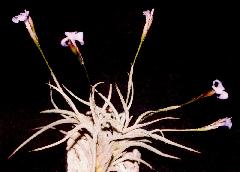
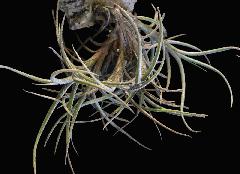
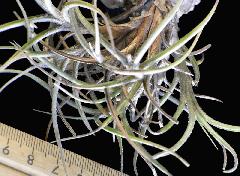
| Ken Woods 02/05 |
Ian Hook 08/08 |
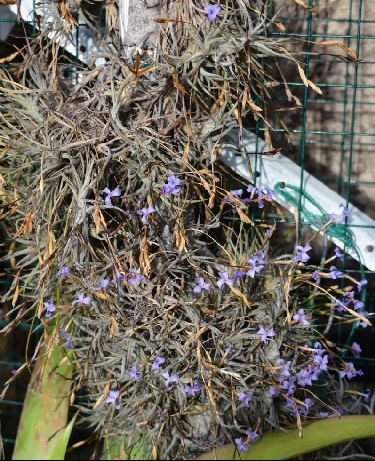
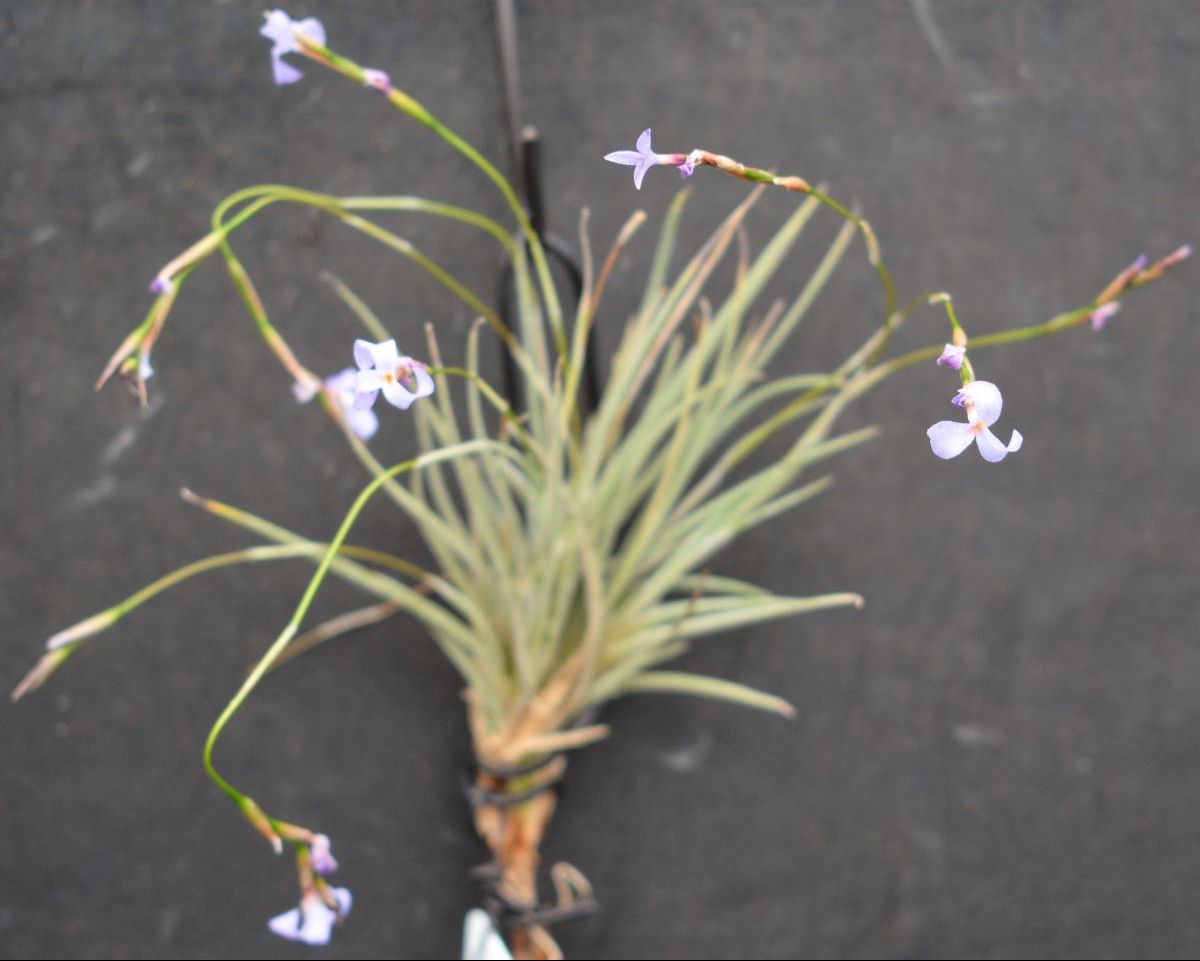
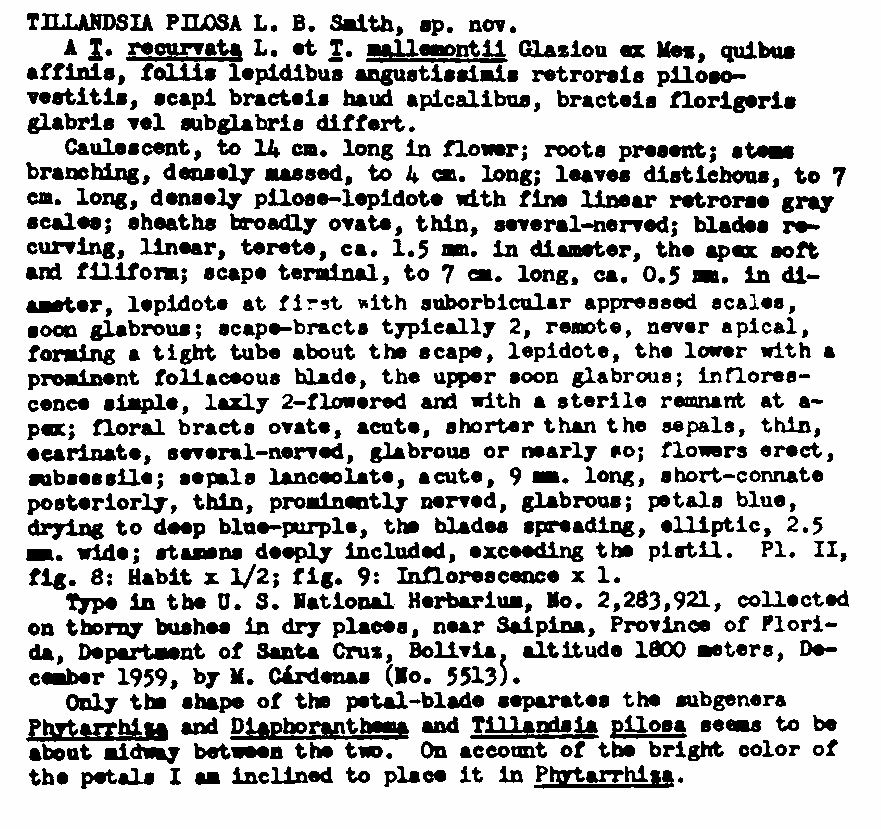
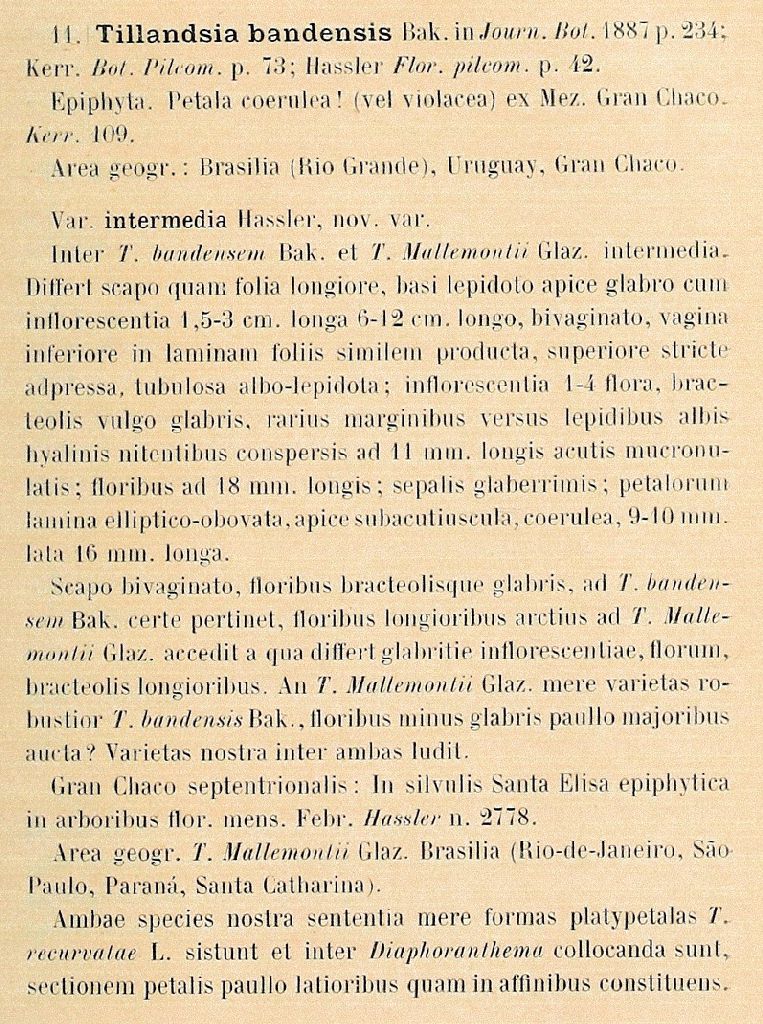
| Chris Larson 02/17 Collected |
Chris Larson 02/17 Holm |
Derek Butcher. bandensis as pilosa |
Derek Butcher. bandensis intermedia |
Chris Larson ... "Here are a couple of forms of T. bandensis. The foliage is quite different.
One I collected in 1998, the other from Holm. The Holm one was growing in a darker position with the flowers growing though other stuff – so the peduncles are long and lax. Both make nice specimens."
Derek Butcher ... "In the old days we used to grow T. pilosa! I find historical references very interesting and how botanists did their comparisons. Others may be interested in the attached.
Surely someone is growing a white petalled form I can get my teeth into!"
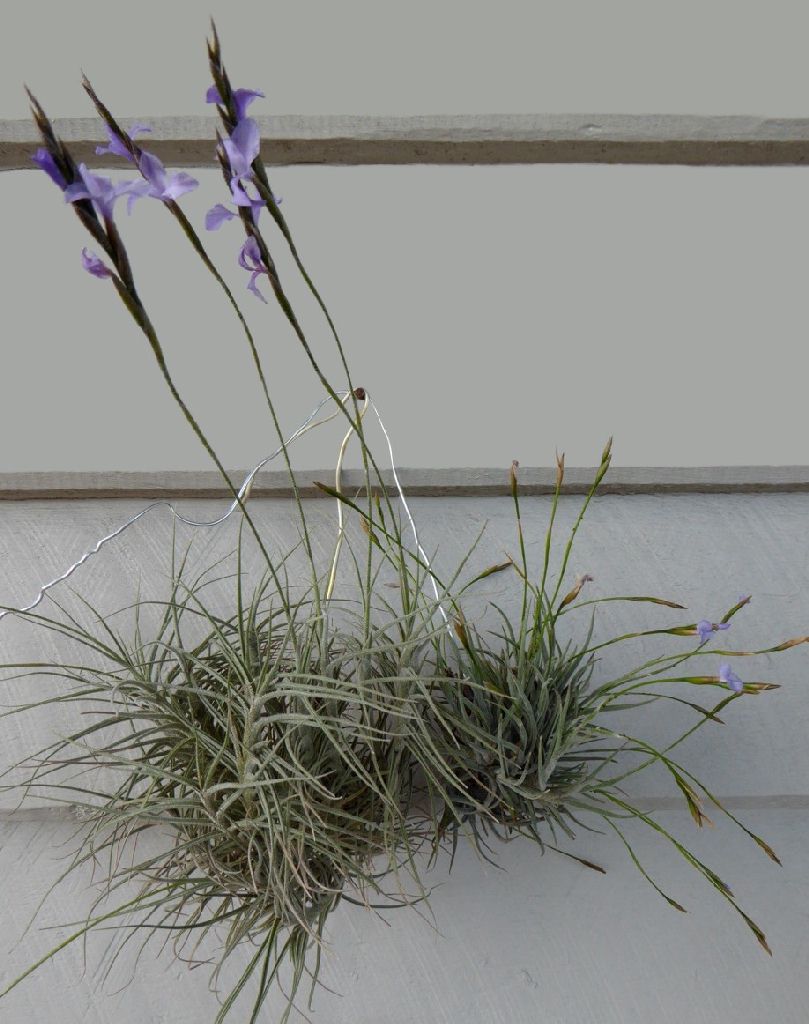
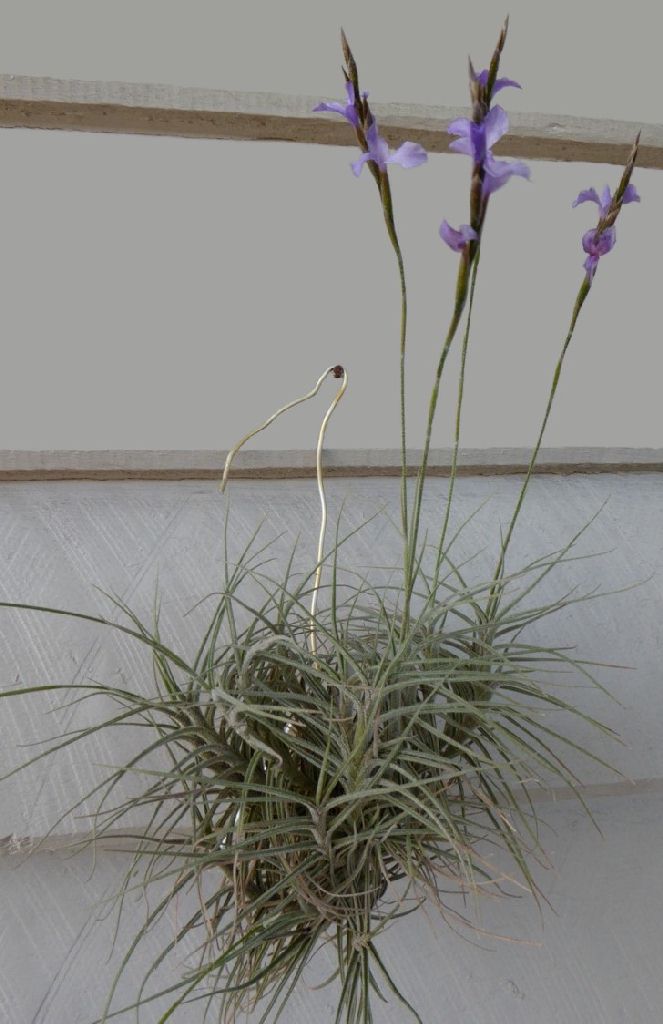
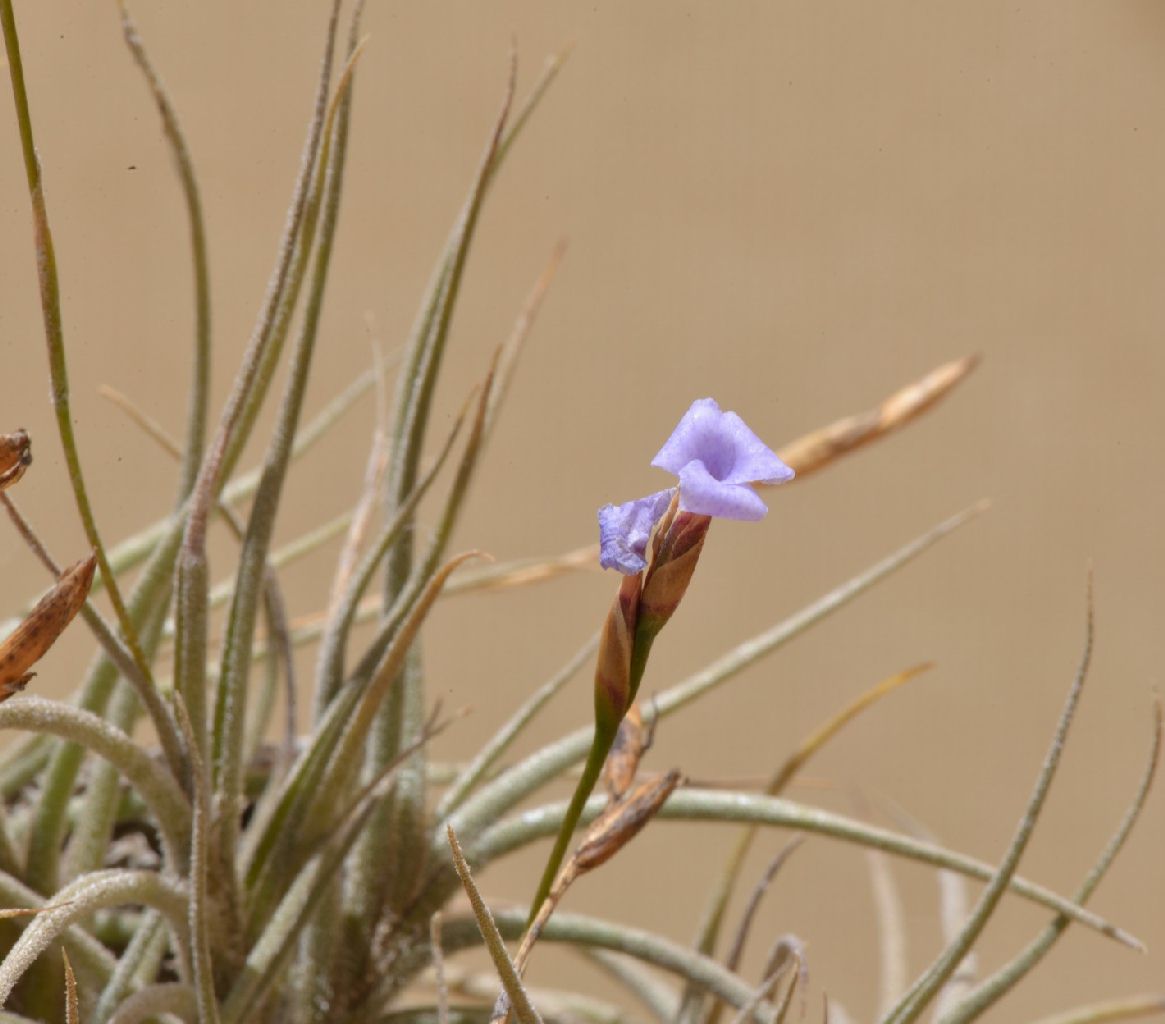
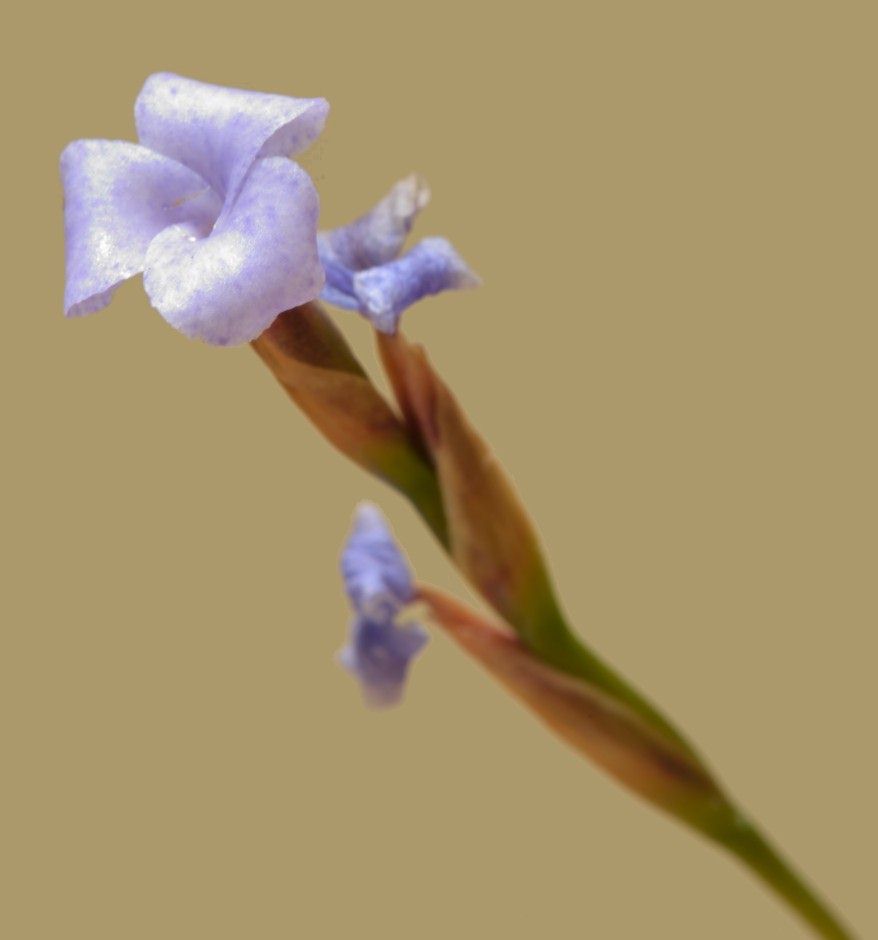
| Bruce Dunstan 12/17 |
George Nieuwenhoven 01/19 |
Bruce Dunstan ... "I have had this species for ever and never really paid it any attention until I visited Bob Hudson in Cairns and saw his large clone. I love the distichous foliage of Bob's plant.
It has flowered for me along with my much smaller plant. I have another form that I'm still waiting on buds to open. Quite a variation between these two. Do others notice variations between different forms of this species?"
Rob Bower ... "My bandensis is flowering too and it looks like the form on the right of the image. Your image prompted me to find the plant I got from Bob Hudson and sure enough it is about to flower and the inflorescence and the distichous foliage is exactly the same as the plant on the left – but I got it from Bob as bandensis x mallemontii."
George Nieuwenhoven ... "A steady grower in Adelaide."
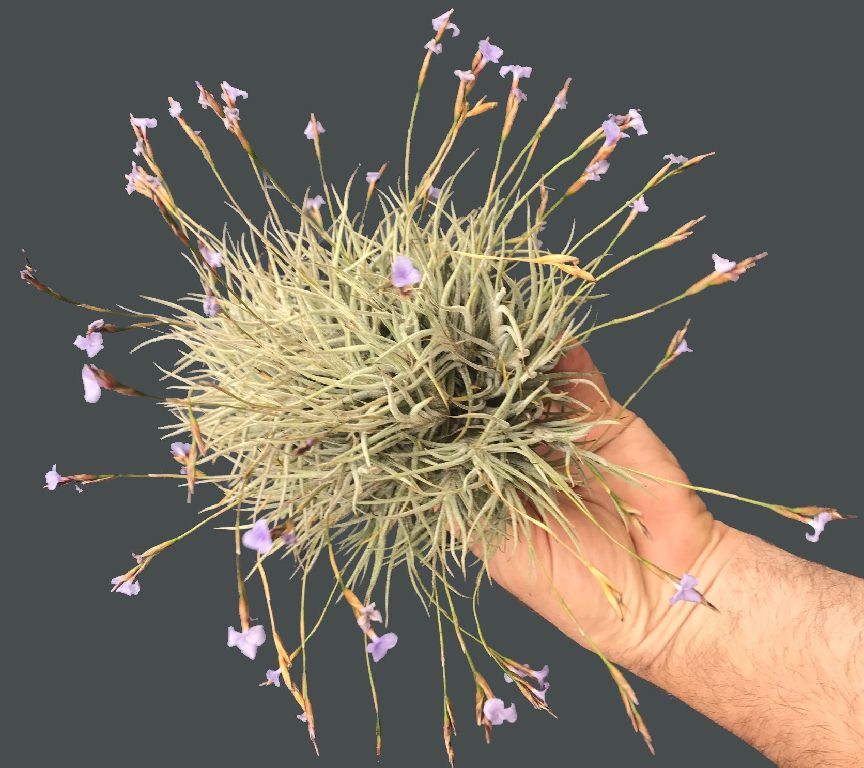
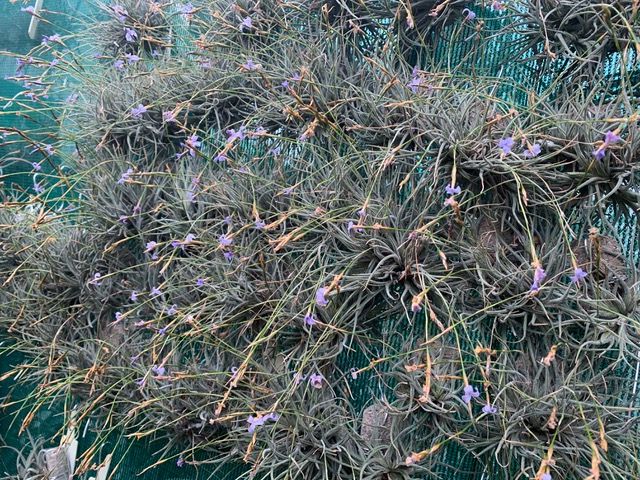
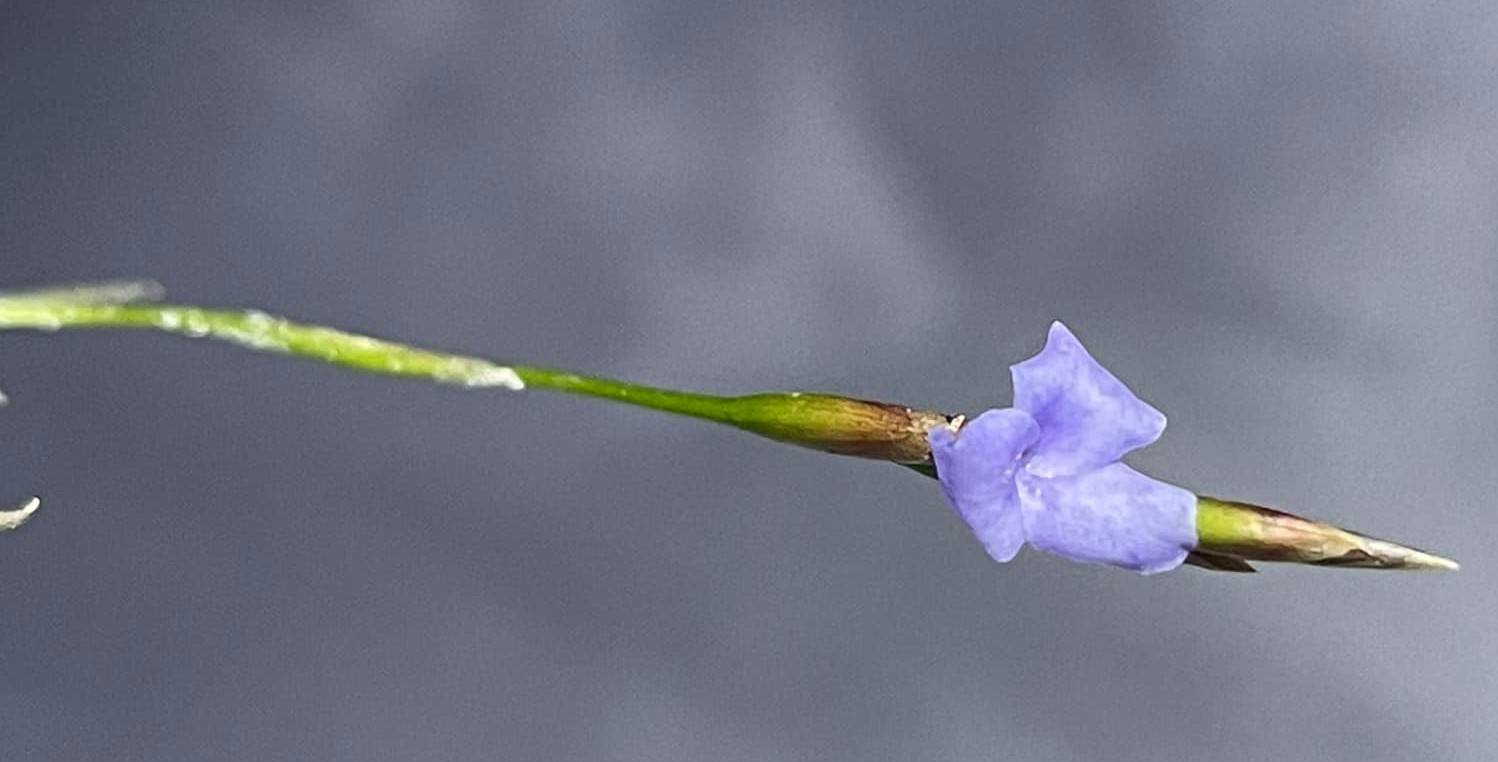
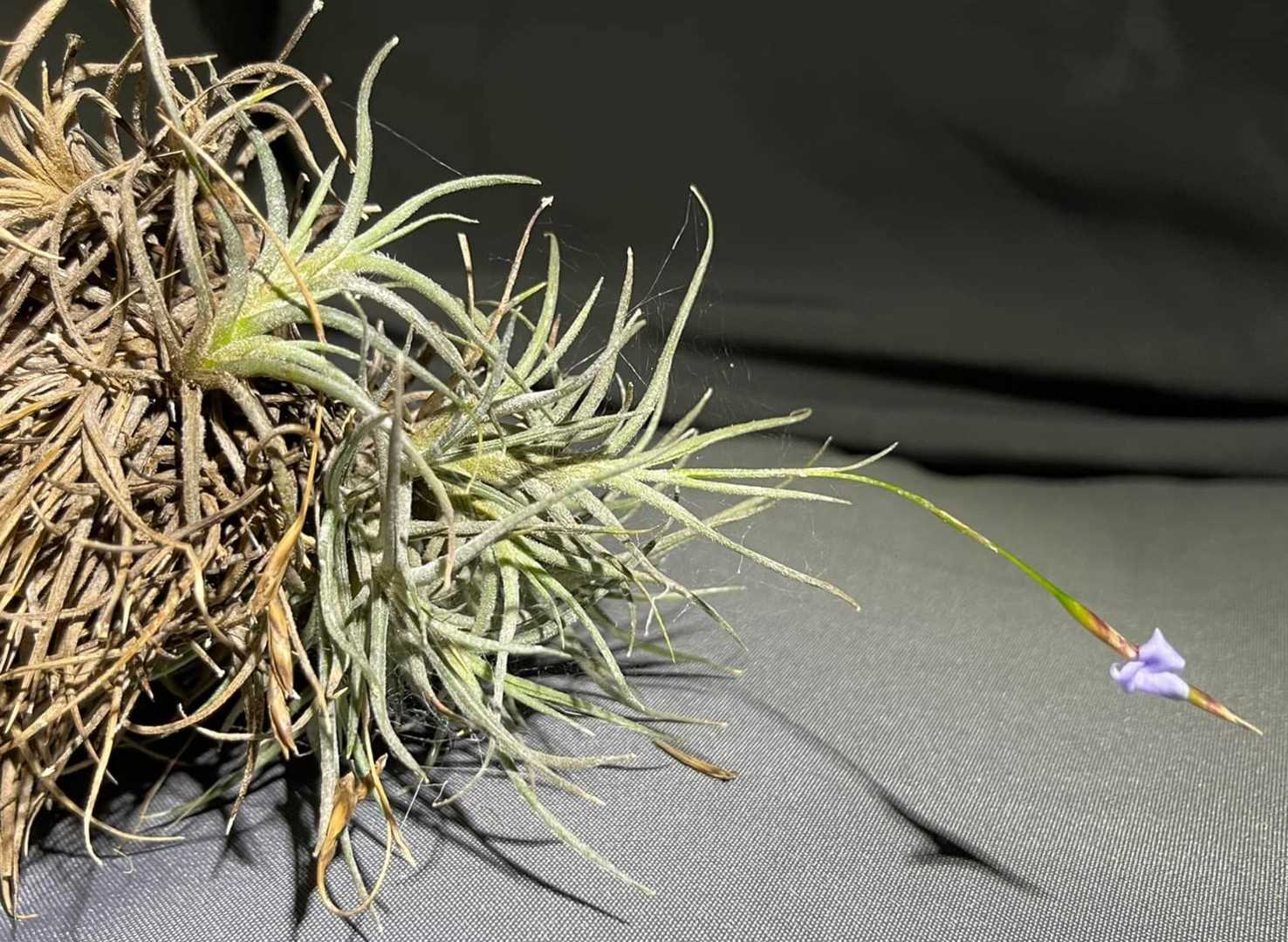
| Ray Clark 01/20 |
Bruce Dunstan 01/20 Full sun Bris. |
Ian Cook 01/22 |
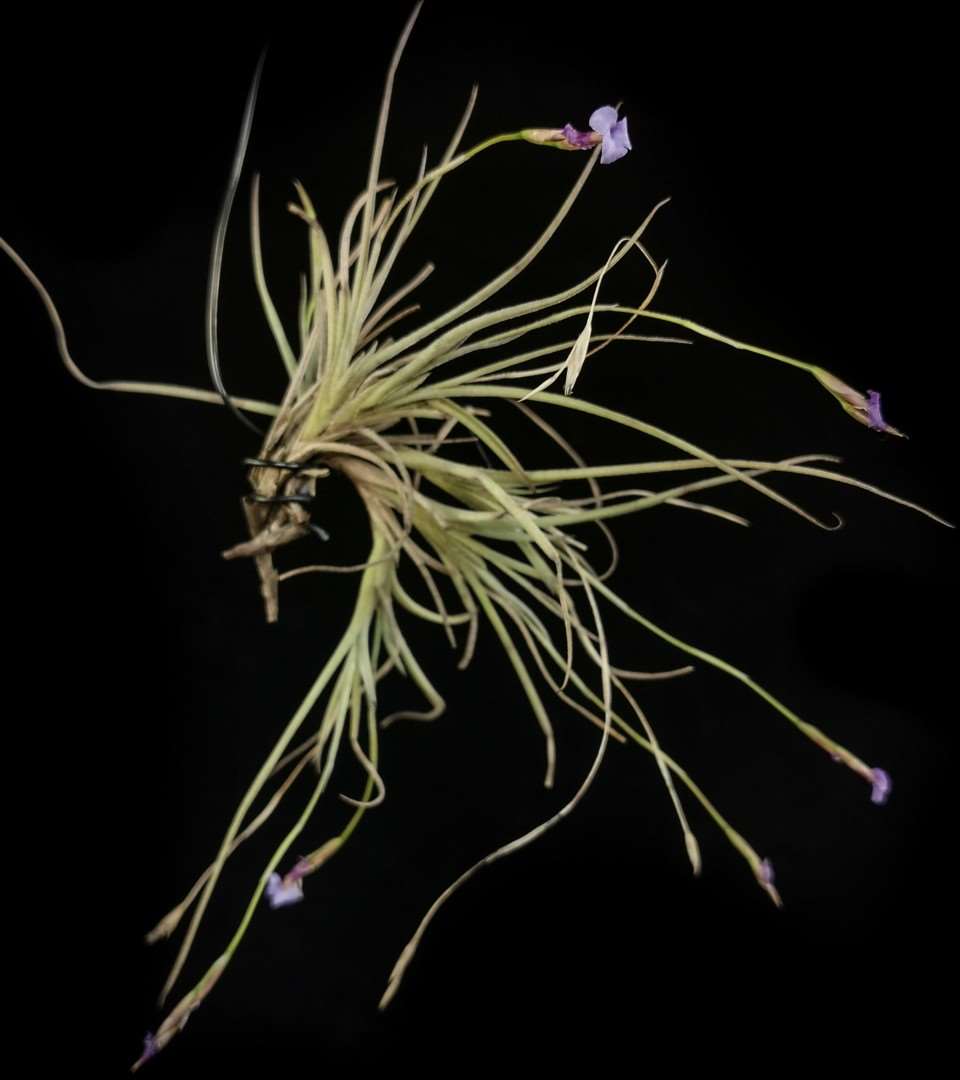
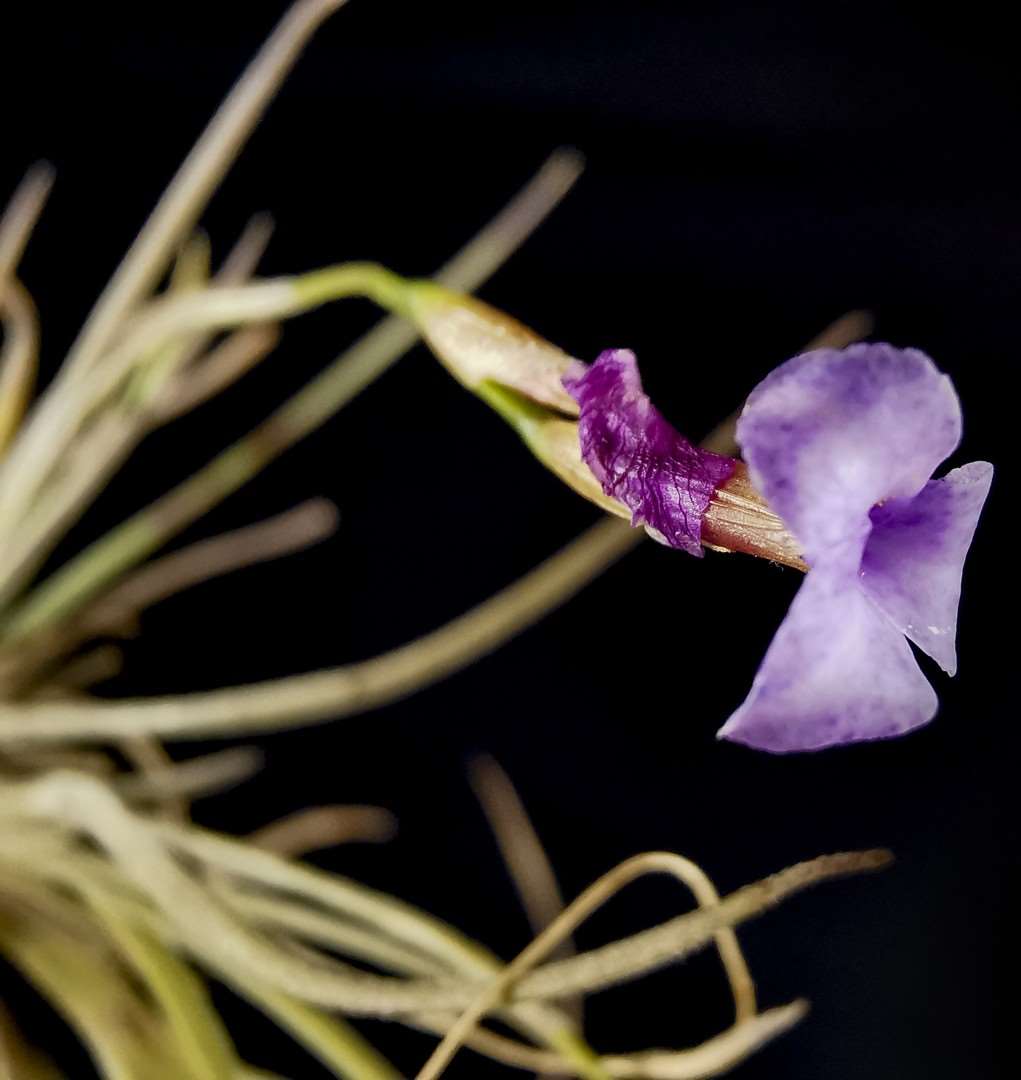
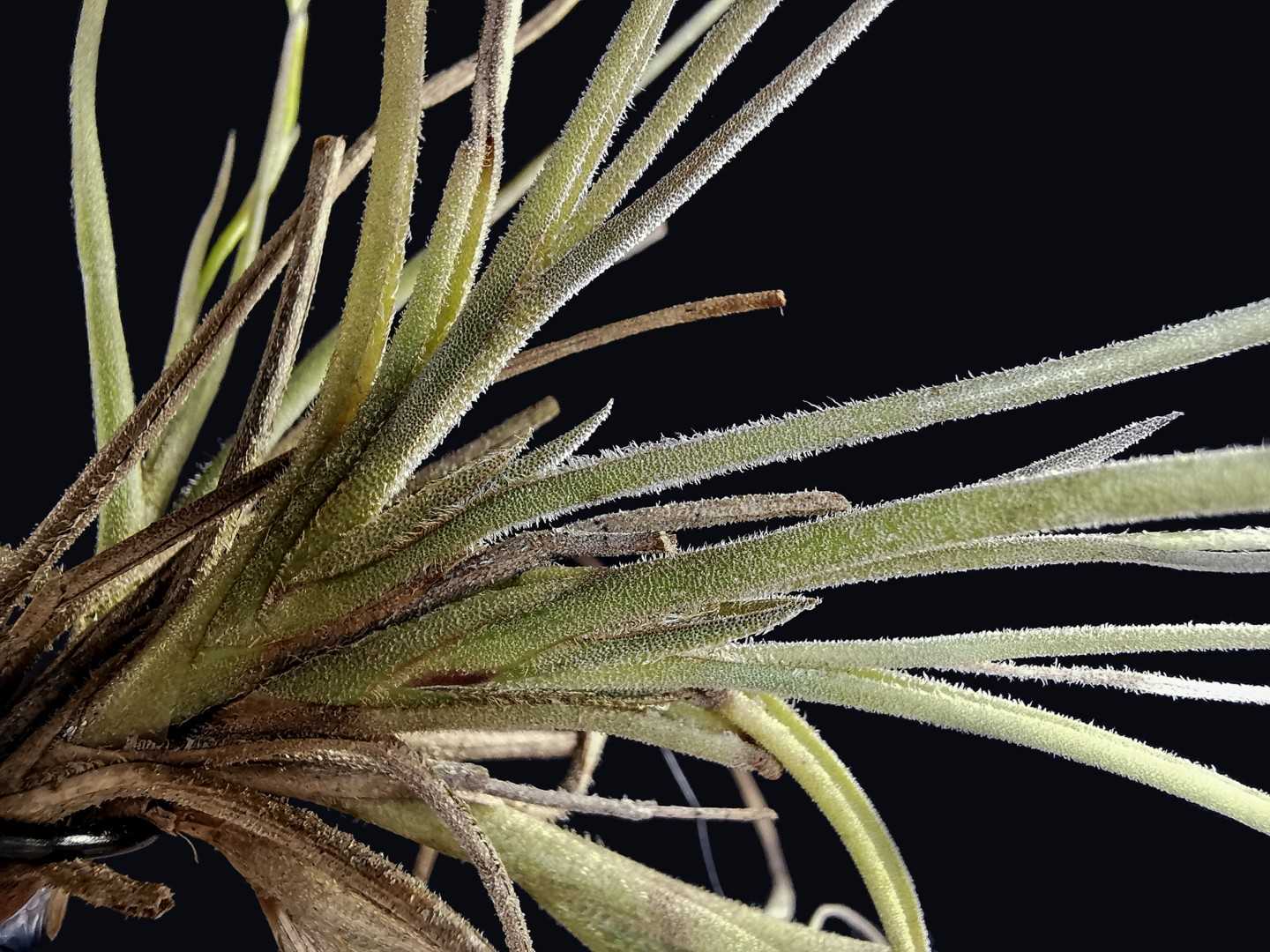
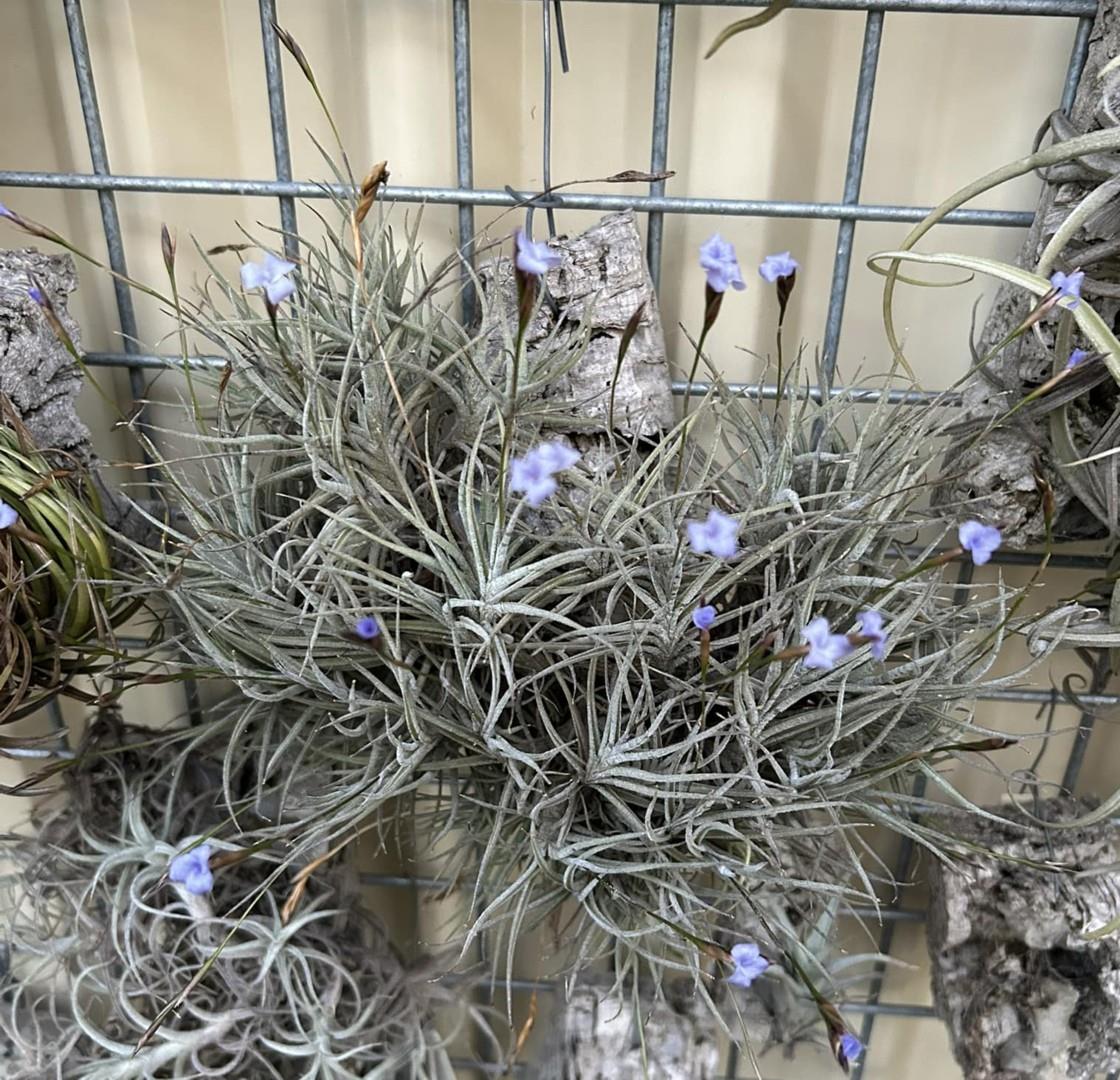
| Lloyd Godman 03/21 as 'Bandoo or Bandro' ? |
George Nieuwenhoven 12/24 |
Lloyd Godman ... "I found this plant yesterday with the name Tillandsia bandoo or maybe bandro?
Can not find any info on it all - maybe a MP hybrid that never got registered. Does anyone have any ideas on this one ?"
Chris Larson ... "Any reason to think it not a straight bandensis?"
Geoff Lawn ... "No, I couldn't trace that name or similar anywhere. It rather looks like the fcbs.org photo of T. bandensis. Why not try keying it out to that species or wherever it takes you ?"
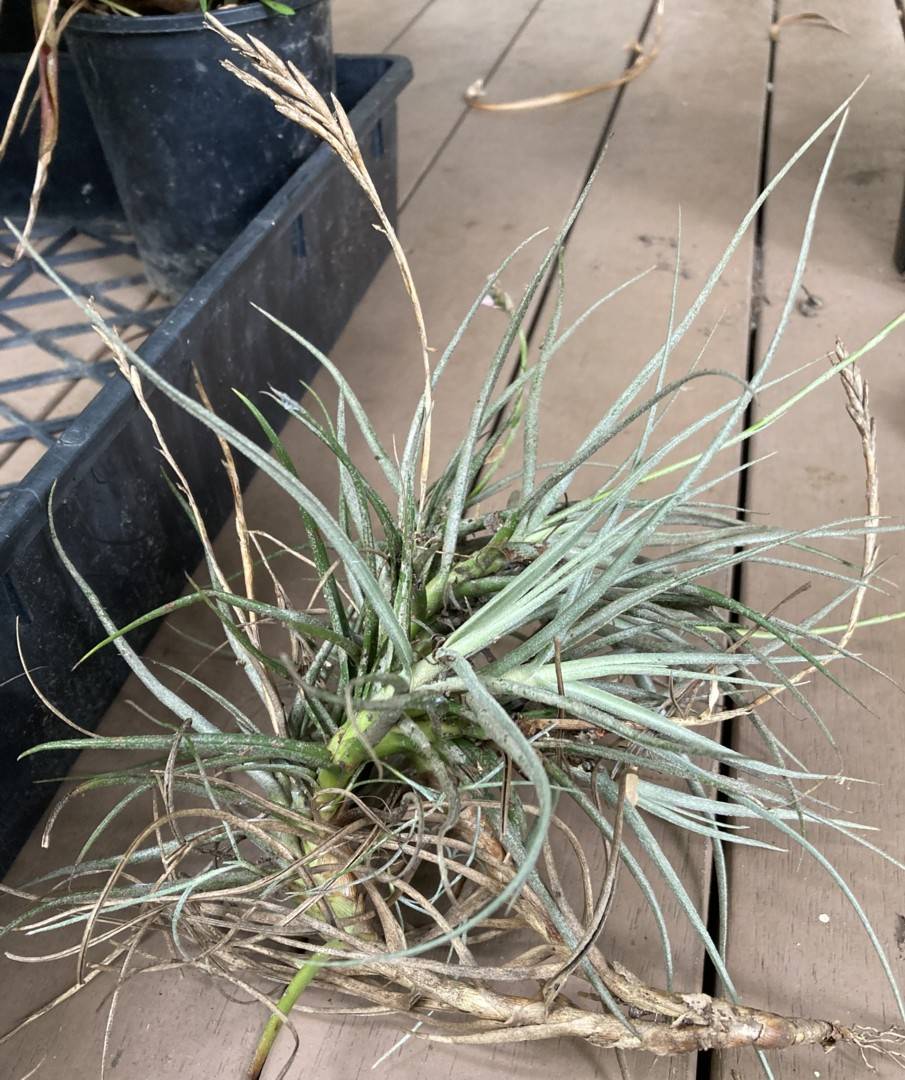
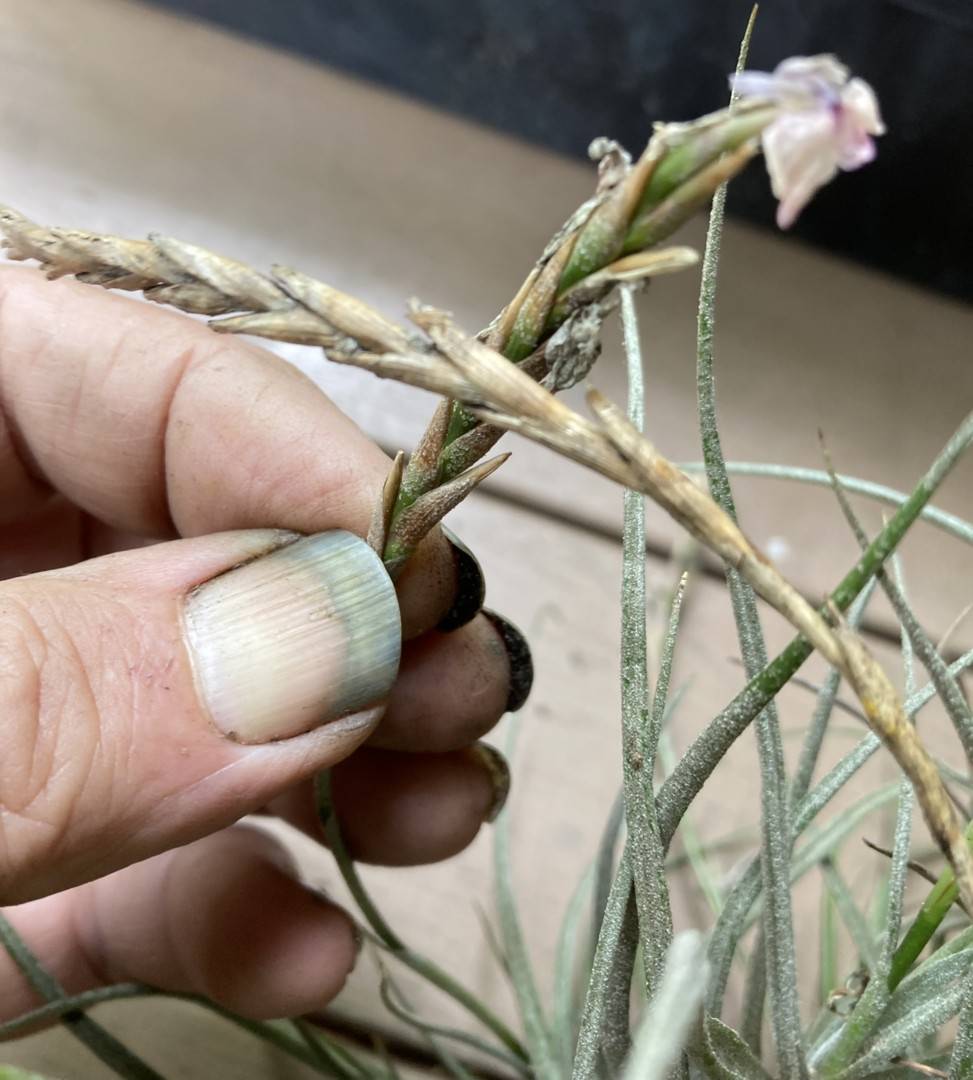
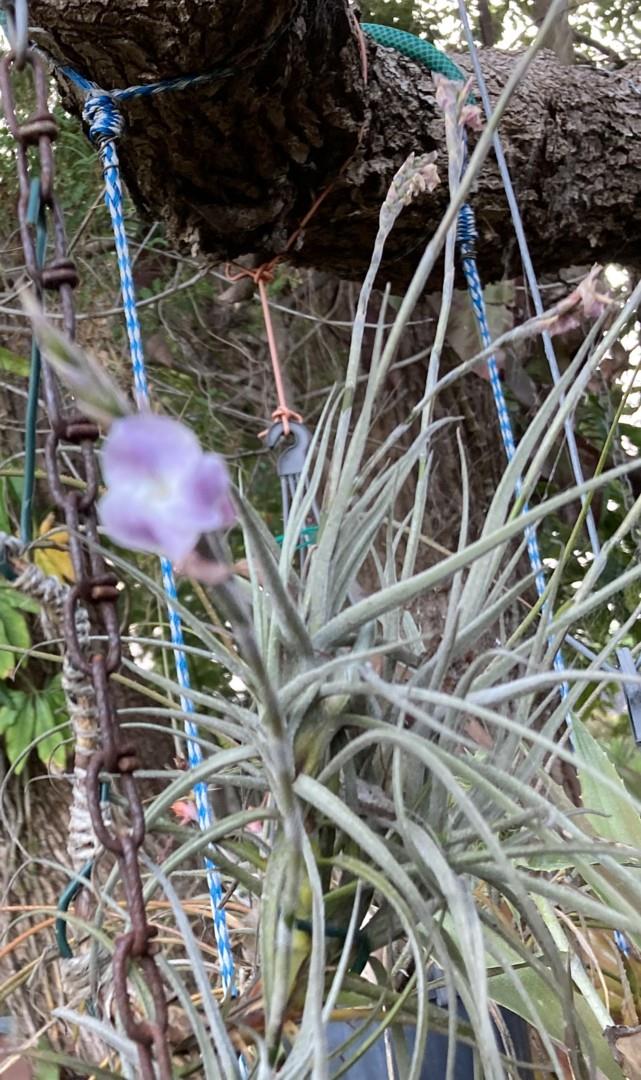
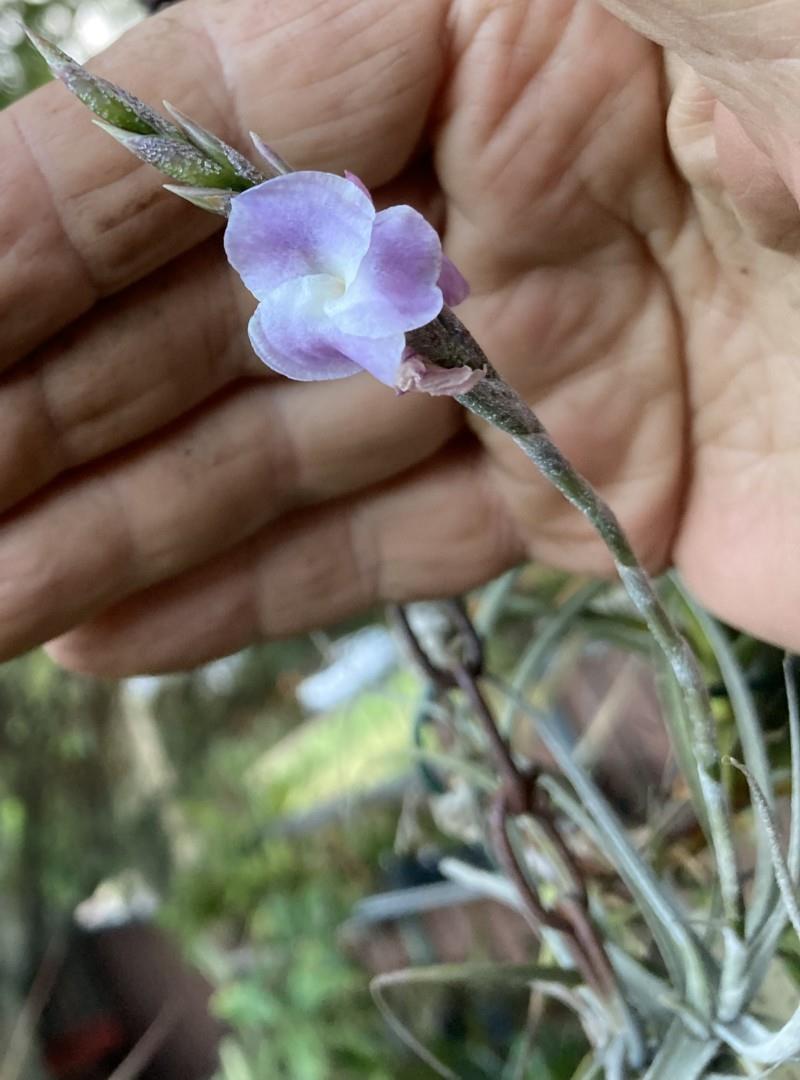
| Ian Hook 02/23 lost tag, probably paleacea |
Ian Hook 11/24 lost tag, probably paleacea |
Tillandsia bandensis Baker, Jour. Bot. London 25: 234. 1887.
Tillandsia quadriflora Baker, Handb. Bromel. 163. 1889; in part, as to Miers 1363 (BM), Uruguay, not as to type.
Tillandsia recurvata var majuscula Mez in Martius, Fl. Bras. 3(3): 611. 1894. Type. Uruguay, Tweedie s n (K).
Tillandsia bandensis var intermedia Hassler, Ann. Conserv. & Jard. Bot. Geneve 20: 333. 1919. Type. Paraguay, Gran Chaco, Santa Elisa, 23° 10' S, HassIer 2778 (BM, G-B, GH), Feb 1903.
Tillandsia pilosa L. B. Smith, Phytologia 7: 175, pI. 2, figs. 8, 9. 1960. Type. Saipana, Florida, Santa Cruz, Bolivia, Cardenas 5513 (US).
Desc from S&D p870-2
Plant 1-2 dm long; roots present; stem much branched with the branching largely in a single plane, 4-6 cm long.
Leaves densely distichous, 5-7 cm long, densely pruinose- or tomentose-lepidote, cinereous to fuscous;
Sheaths broadly ovate, 1 cm long, glabrous except for the upper half outside;
Blades suberect to spreading, linear-subulate, involute, long-attenuate, 1-2 mm in diameter.
Scape terminal, erect or decurved, to 9 cm long, ca 0.5 mm in diameter, sulcate, lepidote at least below;
Scape-bracts 1-2, remote, much shorter than the internodes, elliptic, the upper acute or apiculate and usually glabrous, the lower usually filiform-laminate and appressed-Iepidote.
Inflorescence always simple and distichous-flowered, linear-Ianceolate, 2-3 cm long, 3-5 mm wide, 2-4-flowered;
Rhachis slightly flexuous, very slender, excavated next the flowers, glabrous.
Floral bracts not at all imbricate, equaling or slightly longer than the internodes, ovate-elliptic, acute, more or less nerved, 9-12 mm long, the lower ones equaling or somewhat shorter than the sepals and sometimes sparsely lepidote, the upper ones much shorter than the sepals and glabrous;
Flowers erect, appressed to the rhachis; pedicels very short, obconic.
Sepals subelliptic, acute, 8-10 mm long, 2.5-3 mm wide, thin, nerved, glabrous, equally subfree;
Petals 15-16 mm long, claw narrow, blade broadly elliptic or obovate, 5 mm long, 6 mm wide, blue or violet;
Stamens deeply included, exceeding the pistil, anthers linear;
Ovary subprismatic, passing gradually into the short style.
Capsule cylindric, ca 2 cm long.
Type. Tweedie s n (holotype K, GH photo), without exact locality, Uruguay. DISTRIBUTION. Epiphytic m dry woods, 300-2000 m alt, Bolivia, Paraguay, Uruguay, Argentina.
BOLIVIA. SANTA CRUZ, Valle Grande: Cerrode Alto-Mairana, 21 Dec 1921, Steinbach 6039 (F, GH, US). URUGUAY. SALTO: 1924, Schroder in Osten 17768-B (GH, MVM). COLONIA: Carmelo, 2 Feb 1922, Schroder in Osten 16442 (GH, MVM). ARGENTINA. JUJUY: Quinta, Laguna La Brea, 24 Jul 1901, Fries 417 (S, US); Perico, 19 Jan 1930, Parodi 9041 (BAA); Puerto Viejo, 11 Feb 1935, Castellanos s n (BA); Pampa Blanca, 29 lan 1937, CasteIlanos s n (BA); San Lucas, San Pedro, 20 May 1945, Herrera 559 (LIL, NY); Jujuy to Urundel, 1948, Humbert 21155 (P). SALTA: Sierra de la Candelaria, 30 Aug 1924, Venturi 8667 (GH, US); El Dique, Coronel Moldes, 15 Feb 1943, BartIett 19698 (MICH, US); Yuchan, Oran, 22 May 1945, Herrera 540 (LIL, NY). CATAMARCA: Lomas de Choya, Capital, Dec 1910, Castillon 14110 (GH, NY, UC, US); La Carrera, Valle Vieja, 24 May 1944, VareIa 163 (UC); Sierra de Ancasti, Ancasti to Icano, 21 Dec 1963, Ragonese & Piccinini 9818 (BAB, US). TUCUMAN: Burruyacu, 6 Feb 1903, Stuckert 12803-A (G); Vipos, Trancas, 22 Dec 1907, Lillo 7311 (GH, NY, LIL); 6 Jan 1922, Schreiter 1265 (GH, MVM, NY); 24 Dec 1923, 6588 (GH, LIL, NY); Chafiar Pozo, Lea1es, 1 Dec 1919, Venturi 735 (GH, NY, US); Tapia, Trancas, 12 Dec 1920, Venturi 1119 (BA, F, GH, MVM, S, US); El Duraznito, Capital, 6 Jan 1924, Venturi 2801 (BA, MVM, S, US); Rio Loro on Rio Sali, Jan 1933, Diaz s n (GH); Trancas, Oct 1939, Meyer 3358 (GH); Macomita, Burruyacu, 10 Mar 1947, Varela s n (LIL, US). SANTIAGO DEL ESTERO: La Paril1a, Gancedo, 17 Jul 1924, Castellanos 24/1318 (BA, GH); La Punta, Guasayan, 3 Dec 1943, Castellanos s n (BA). FORMOSA: 300 miles above mouth of Rio Pilcomayo, Kerr 109 (K); Formosa, Jan 1918. Jorgensen s n (MVM, S); Oct 1918, 2010 (GH, MO, NY, US). CHACO: Colonia Benitez, Feb 1935, Schulz 810 (GH). SANTA FE: Chanday, 5 Apr 1917, Hosseus 46 (CORD); Rio Parana Mini, 13 Aug 1918, Hosseus 13 (CORD); Gallareta, 4 Jan 1937, Castellanos s n (BA). ENTRE RIOS: Delta del Parana, 27 Feb 1938, Burkart 8921 (SI); 1 Mar 1938, 8935 (SI); Ceibas to Medanos, 19 Sep 1961, Burkart 22495 (SI). BUENOS AIRES: Delta del Parana, 28 Dec 1902, Hicken s n (SI); Dec 1916, Hauman s n (BA); 20 Jan 1931,Cabrera 1634 (GH,SP).
Detail from Studies in Bromeliaceae by Lyman Smith VI p185. 1935
Mez's citations of T. bandensis are so badly mixed geographically that it is not possible to use them without further checking, although I have little doubt of their taxonomic accuracy. The main trouble is his interpretation of the old term, "Banda Oriental," as Paraguay, when it should be Uruguay. In addition I can find no basis for his considering that the Tweedie material came from Brazil.
As already pointed out in Ostenia, Hassler's var. intermedia differs from Mez's description of the type of T. bandensis but not from the type.
From p209
Venturi 2801 from El Duraznito, Tucuman, Argentina, is evidently a hybrid of T. recurvata and T. bandensis both of which occur in the same locality. The specimens of that number show various degrees of variation between the two species in the density of the inflorescence and its amount of indument.
Tillandsis pilosa L. B. Smith, Phytologia 7: 175, pI. 2, figs. 8, 9. 1960. See above
A T. recurvata et T. mallemontii Glaziou ex Mez, quibus affinis, foliis lepidibus angustissimis retrorsis piloso-vestitis, scapi bracteis haud apicalibus, bracteis florigeris glabris vel subglabris differt.
Caulescent, to 14 cm. long in flower; roots present; stems branching, densely massed, to 4 cm. long;
leaves distichous, to 7 cm. long, densely pilose-lepidote with fine linear retrorse gray scales;
sheaths broadly ovate, thin, several-nerved;
blades recurving, linear, terete, ca, 1.5 mm in diameter, the apex soft and filiform
scape terminal, to 7 cm. long, ca. 0.5 mm. in diam, lepidote at first with suborbicular appressed scales, soon glabrous;
scape-bracts typically 2, remote, never apical, forming a tight tube about the scape, lepidote, the lower with a prominent foliaceous blade, the upper soon glabrous;
inflorescence simple, laxly 2-flowered and with a sterile remnant at apex;
floral bracts ovate, acute, shorter than the sepals, thin, ecarinate, several-nerved, glabrous or nearly so;
flowers erect, subsessile;
sepals lanceolate, acute, 9 mm. long, short-connate posteriorly, thin, prominently nerved, glabrous;
petals blue, drying to deep blue-purple, the blades spreading, elliptic, 2.5 mm wide; stamens deeply included, exceeding the pistil.
Pl. II, fig. 8: Habit x 1/2; fig. 9: Inflorescence x 1.
Type in the U. S. National Herbarium, No. 2,283,921, collected on thorny bushes in dry places, near Saipina, Province of Flori¬da, Department of Santa Cruz, Bolivia , altitude 1800 meters, De¬cember 1959, by M. Cardenas (No. 55131)
Only the shape of the petal-blade separates the subgenera Phytarrhiza and Diaphoranthema and Tillandsia pilosa seems to be about midway betwen the two. On account of the bright color of the petals I am inclined to place it in Phytarrhiza.
From Baker 1889
26. T. BANDENSIS Baker in Journ. Bot. 1887, 234.
Leaves spread over a short stem, subulate, ascending, 1 ½ - 2 in. long, 1/12 in. diam. low down, rigid, deeply channelled down the lower part of the face, densely clothed with fine grey lepidote scales. Peduncle slender, flexuous; bract-leaves 2, small, adpressed. Flowers 3 in a lax.spike; flower-bracts oblong, cuspidate, 1/3 in. long. Calyx sub-cylindrical, 1/2 in. long; sepals acutc. Petal-blade obovate, spreading, reddish-lilac, ¼ in. long. Stamcns not longer than the calyx.
Hab. Uruguay, Tweedie. Near T. linearis.
From Mez 1935
359. T. bandensis Bak. in Journ. of Bot. XXV. (1887) 234; Castellanos in Anal. Mus.
Argent. Ci. Nat. XXXVII. (1933) 498.
T. quadriflora Bak. Bromel. (1889) 163, e. p.
T. recurvata var. majuscula Mez in Mart. Fl. Brasil. III. 3. (1894) 671.
Manifeste sed breviter caulescens, vix ultra 0,1 m alta. Folia sueto optime distiche ordinata, ad 50 mm longa et 1-1,5 mm crassa, subulata, acutissima, lepidibus magnis pruinosa. Scapus tenuissimus, foliis brevior, vaginis 1-2 tubulose appressis, quam internodia conspicue brevioribus, appresse lepidotis praeditus. Inflorescentia simplicissima, optime disticha, 2-5-flora, glabra, vix ultra 20 mm longa; bracteis ovato-ellipticis, acutis, submembranaceis, laevibus, usque ad 9 mm longis, glabris, quam sepala permanifeste brevioribus. Flores stricte erecti, glabri, ad 15 mm longi; sepalis subaequaliter liberis, chartaceis, laevissimis, subellipticis, acutis. Petalorum laminae violaceae, late obovatae subrhombiformes, patentes, Stamina profunde inclusa, stylum superantia.
Brasilien: Staat Rio Grande do Sul (Tweedie). Uruguay (Arechavaleta n. 2612, Kerr n. 109, Tweedie n. 6). Paraguay (Fleischer, Miers n. 1363). Argentina: Prov. Tucuman (Kurtz n.4146 e.p.); Prov. Jujuy, Rio Chijra (Schreiter n. 2605); Prov. Salta, Oran (Ragonese n. 31/1734), Gran Chaco Salteno, Ipaguazo (Calcagnini in herb. Min. Agr. n.7783), Rio Juramento (Castellanos); Prov. Catamarca, Quebrada de Totoral, Concepcion (Castillon n. 6601), El Valle (Spegazzini n. 159), El Alto, Balcosna (herb. Venturi n.7184); Prov. Cordoba, San Javier, Yacanto (Molfino {II. 1921}); Prov. Santa Fe, Malabrigo, F. C. a. Reconquista (Schroeder in herb. Min. Agr. n. 25602); Prov. Entre Rios, Concordia, Duraznal (Castellanos n. 31/978).
Var. intermedia Hassl. in Ann. Conserv. et Jard. bot. Geneve XX. (1919) 333; Castellanos in Physis X. (1930) 86, t. II.
Inter T.bandensem et T. Mallemontii intermedia.
Differt scapo quam folia longiore, basi lepidoto apice glabro cum inflorescentia 1,5-3 cm
longa 6-12 cm longo, bivaginato, vagina inferiore in laminam foliis similem producta, superiore stricte appressa, tubulosa albo-lepidota; inflorescentia l-4-flora, bracteolis vulgo glabris, rarius margines versus lepidibus albis hyalinis nitentibus conspersis ad 11 mm longis, acutis mucronulatis; floribus ad 18 mm longis; sepalis glaberrimis; petalorum lamina elliptico-obovata, apice subacutiuscula, coerulea, 9-10 mm lata, 16 mm longa.
Argentina: Buenos Aires, delta del Parana (Hicken n. 101, Hauman n. 28/1131,
Castellanos n. 1128); Santiago del Estero, La Parilla (Castellanos n. 24/l318); Sotelo (de Carles n. 1130); Tucuman, Vipos (Schreiter n.27/2340), bei Tucuman (Castellanos n. 26/2375, herb. Venturi n. 24/86), Tapia (Castellanos n. 1237), Chanar Pozo (Castellanos n. 1127); La Rioja, General Roca, San Francisco (Gomez n. 28/744; Chaco, Sta. Elisa (Hassler n. 2278), Resistencia (Castellanos n. 24/1246); Formosa (Jorgensen n. 1129).
Dale Dixon
I can’t remember if this has been discussed here but I just discovered that Tillandsia bandensis has been divided into two subspecies based on the size of some reproductive structures and density of scales on the floral bracts. Now we have bandensis subsp. bandensis and bandensis subsp. grandipetala. The paper was published in May 2019.
I know that there is the 'large form' of Tillandsia bandensis sold at various shows. I have one from Peter Tristram and from Bruce Dunstan I think.
Has anyone looked at their plants in detail to see if the subspecies grandiflora conforms to the description of the large form sold here in Australia ?
I do not have the paper yet (requested) but I've compiled a quick key based on the differences in the descriptions in the encyclopedia.
Key to subspecies of Tillandsia bandensis:
- Floral bracts glabrous or trichomes occasionally at margin and/or apex; flowers 11-18mm long; faintly fragrant => subsp. bandensis
- Floral bracts densely to subdensely lepidote, generally denser at margins and apex; flowers (15)17-22 mm long; strongly fragrant => subsp. grandipetala
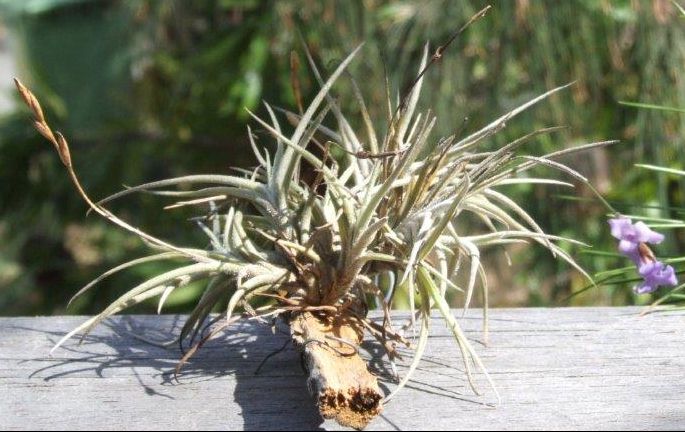
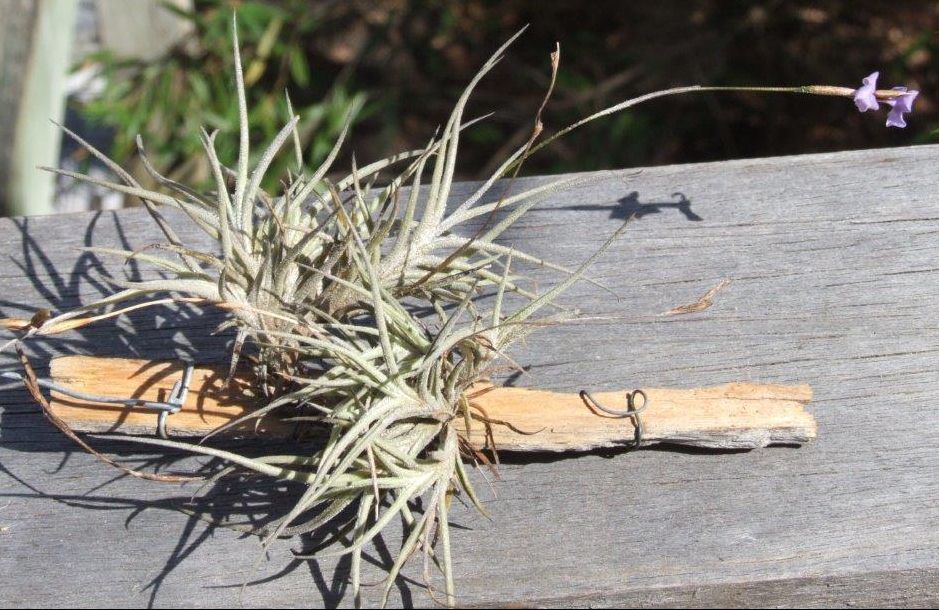
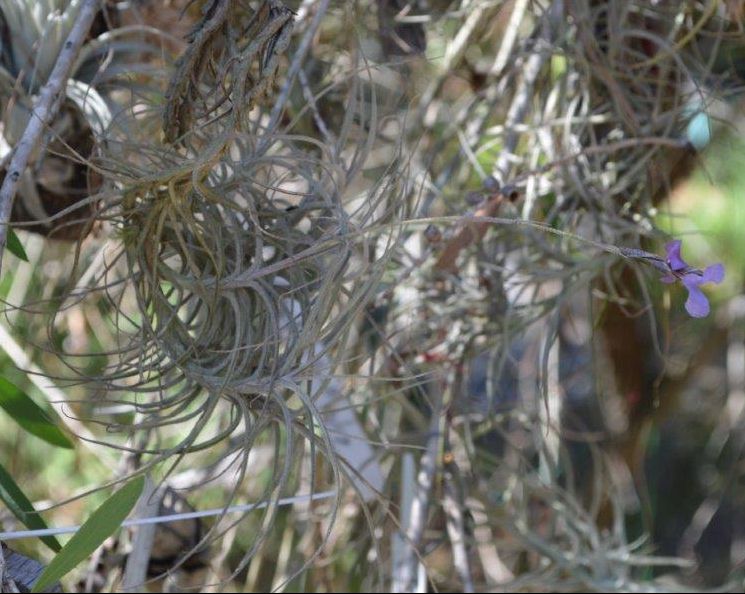
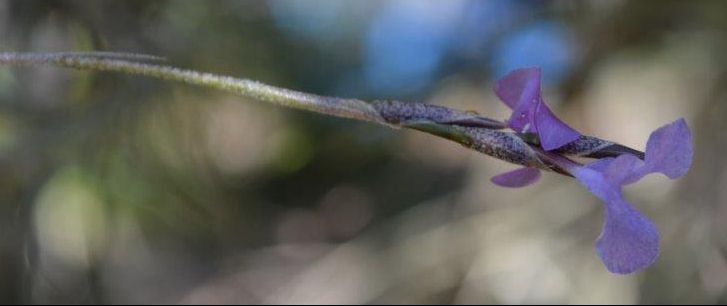
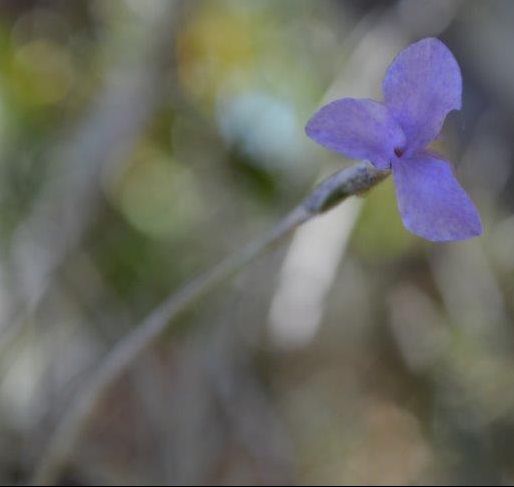
| Rob Bower 03/20 ssp. grandipetala? |
Rob Bower 03/20 distichous form - ssp. bandensis? |
Updated 24/12/24



























